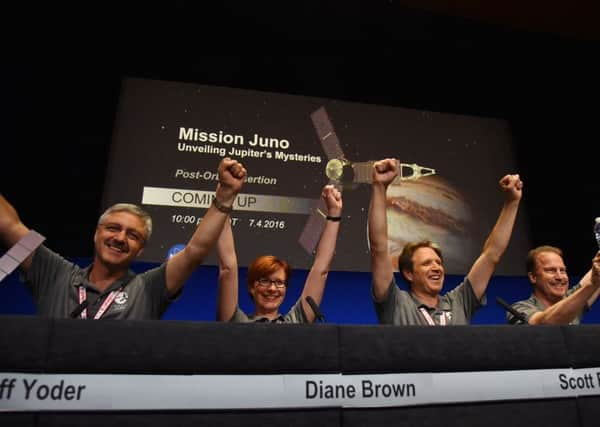Juno space probe in orbit of Jupiter after five-year voyage


The spacecraft, named after the Roman goddess, completed a high-stakes manoeuvre which saw it fire a rocket to slow its 150,000mph (250,000kph) approach to the planet.
Cheers and applause erupted in mission control at Nasa’s Jet Propulsion Laboratory (JPL) at the California Institute of Technology when a signal arrived confirming the burn was complete at around 4:54am.
Advertisement
Hide AdAdvertisement
Hide AdThe mission’s chief scientist, Scott Bolton, congratulated his team, saying “you’ve just done the hardest thing Nasa’s ever done” as the technicians and scientists celebrated completing the complex approach.
However the mission still faces the huge challenge of operating the 1.1 billion US dollar (£890 million) probe in one of the solar system’s harshest environments, where circuitry-frying levels of radiation and high-velocity dust and particles will be a constant threat.
Should all go to plan, Juno’s instruments and camera could provide insights into the history of the solar system and return stunning images of the planet.
The spacecraft began the perilous final stage of its journey in the early hours of yesterday with a 35-minute blast from its rocket engine.
The probe’s Twitter profile announced: “Main engine burn is go. I’m burnin’, burnin’, burnin’ for you, #Jupiter” adding later “Engine burn complete and orbit obtained. I’m ready to unlock all your secrets, #Jupiter. Deal with it.”
It was a critical period for Juno as it hurtled towards the behemoth, with a risk the probe may have shot past the planet and into oblivion if the scientists’ calculations were not absolutely correct.
They planned to bring the spacecraft within 2,900 miles of Jupiter’s swirling cloud tops, a region of space blasted by the highest levels of radiation in the solar system.
Mission control commentator Jennifer Delavan, of Lockheed Martin, which built Juno, announced “Juno, welcome to Jupiter” when the arrival was confirmed.
Advertisement
Hide AdAdvertisement
Hide AdThe titanium-armoured probe’s task is to improve our understanding of Jupiter’s formation and evolution by using complex instruments to peer through the thick atmosphere and its famous Great Red Spot.
Juno’s array will study the gas planet’s composition, gravity, magnetic field and the source of its raging 384mph winds, while a panoramic camera will also return images of the planet in detail never seen before.
Scientists hope that analysis of Jupiter’s interior structure will ultimately help them understand the history and formation of the wider solar system.
It will be some days before Juno begins beaming data and images back to Earth, as the spacecraft’s camera and other instruments were switched off for arrival.
The solar-powered probe’s large solar panels were turned away from the Sun for the final approach before being repositioned to breathe life back into the systems.
Juno tweeted: “All rays on me. My solar panels now face the sun. I’m the farthest solar-powered spacecraft from Earth. #Jupiter”
Dubbed the “biggest, baddest planet in the solar system” by the Juno team, Jupiter is surrounded by a field of high radiation streaked with particles energised by its immensely strong magnetic field.
It also has a ring of dust and rock similar to its neighbour, Saturn, posing a further threat to the probe.
Advertisement
Hide AdAdvertisement
Hide AdThe previous record for a close approach to Jupiter was set by Nasa’s Pioneer 11 spacecraft which passed by the planet at a distance of 27,000 miles in 1974.
Only one previous spacecraft, Galileo, which visited Jupiter and its moons from 1995 to 2003, has orbited the planet.
Juno was launched into space by an Atlas V rocket from Cape Canaveral, Florida, on August 5 2011.
The mission is part of the US space agency’s New Frontiers programme of robotic space missions which last year saw the New Horizons craft obtain close-up views of dwarf planet Pluto.
Tuesday’s Google doodle celebrated Juno’s arrival at Jupiter with an 8-bit cartoon of the probe and mission control jumping for joy.
And the European Space Agency tweeted: “Congratulations @NASAJuno - #Juno now orbiting #Jupiter !”
Juno’s epic space voyage by numbers
• It has taken the Juno probe five years to travel 2.8 billion kilometres at an estimated cost for NASA of $1.1 billion.
• It takes 48 minutes and 19 seconds to receive information from Juno,meaning directional controls must be sent ahead of time.
Advertisement
Hide AdAdvertisement
Hide Ad• The probe will enter orbit around Jupiter for 20 months before becoming engulfed by its hydrogen atmosphere.
• Juno is made of 18,698 solar cells, mounted on 30-foot long solar arrays with a combined surface are of 650 feet.
• Juno is the fastest ever man made object, travelling at an estimated top speed of 165,000 mph – 97 times faster than a bullet fired from a gun.